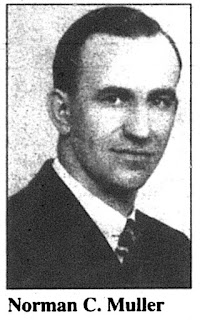 |
| 6 Mile House (also known as Midway Tavern and Whiskeyville Tavern) Courtesy of the Lorain County Historical Society |
Amherst’s Story (1914) by Robert Grenville Armstrong included a few paragraphs about Whiskeyville. It noted that Jacob Shupe had started the first whiskey distillery in the township, and that his success at this enterprise led others to follow suit.
“It is interesting to note in this connection that Whiskeyville received its name from one of these stills, which Elias Mann built there,” wrote Armstrong. "This was in 1838. It is hard to shake a name, once it becomes attached.
“Whiskey, in those early days of scarcity of money, became a legal tender. It served the early pioneer for money. He could pay his notes in whiskey, provided the crop of grain was sufficient. He could use it to replenish his own diminished treasury.”
A book entitled, Amherst Ohio Sesquicentennial mentioned the stagecoach line on which the Midway Tavern had been located. The book noted, “It was during the 1820’s that a stagecoach line began operating between Cleveland and Fremont. It was the first stage line west of Cleveland, and was called the Beebe Stage Coach Line. It traveled west along the South Ridge Road (Ohio 113)."
Regular blog contributor Rick Kurish sent me some information about the tavern that was included in the book Amherst Reflections (July 1976) published by the Amherst Business and Professional Women’s Club. Include in Rick’s information (at left) was a version of the photo shown at the top of this post, and a caption that read, “The “6 Mile House” on the Western Reserve Maumee stage road at the intersection of what are now State Routes 113 and 58 was so-called because it was six miles from the Beebe Tavern in Elyria and an equal distance east of the Henrietta House. The distillery which helped give the neighborhood its name of Whiskeyville, a nickname still heard, was just north, behind the tavern.”
I also made a trip to the Elyria Public Library to see what I could find out about the tavern. A 1926-27 edition of the Directory of Lorain County included a listing for it. “The Midway” was listed as a dance hall run by Edward Sinerson; its address was Telegraph Road in Amherst Township.
The library also had microfilm for the Chronicle-Telegram, and I was able to find that paper’s reporting of the fire that destroyed the tavern. Here is the article (below), which ran on the front page of the C-T on October 6, 1933. It is different from the report that ran in the Lorain Journal.
****
FLAMES DESTROY CENTURY OLD TAVERNLandmark West of Elyria Burns to the Ground,
Origin of Blaze Unknown
Whiskeyville Tavern, century-old landmark and at one time a stage coach stop on Telegraph road, burned to the ground early this morning from a fire of undetermined origin.
Perpetuating its early history, the ancient building, with some modern improvement, had up to the very last been a place of social gatherings and entertainment. Even last night, not long before the disastrous fire broke out, the tavern was the scene of a party and dance.
Recently the tavern had been operated by Mr. and Mrs. Harold Wallace. Awakened about 2:45 a.m. by the acrid odor of smoke, Mr. and Mrs. Wallace discovered the building enveloped in flames. They aroused their two children, and made their escape out over the porch roof.
Amherst Dept. Called
The Amherst fire department and neighbors fought the flames, but were unable to check their progress through the dry timbers. They prevented the flames from spreading to a barn in the rear, and to adjoining buildings, however.
Deputy Sheriff Claude Adams, who responded to the fire call, said that the fire raged for about two hours before it was subsided.
Considered as one of the best taverns in the early history of this section, it never lost its identity as as social center, like so many of its early contemporaries did when automobiles and good roads made their presence felt in American life. It was a popular stopping place until the last, and its passing brings nearer to close that chapter in the early social life of the Western Reserve.
An investigation of the cause of the blaze is to be made by the state fire marshall’s office, Sheriff Clarence W. Dick said.
Next: Just where was the tavern located?















































